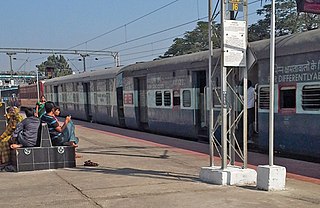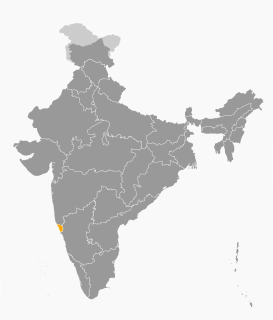
The history of Goa dates back to prehistoric times, though the present-day state of Goa was only established as recently as 1987. In spite of being India's smallest state by area, Goa's history is both long and diverse. It shares a lot of similarities with Indian history, especially with regard to colonial influences and a multi-cultural aesthetic.

Vasco da Gama, often shortened to Vasco, is a city in the state of Goa on the west coast of India. It is named after the Portuguese explorer Vasco da Gama. It is the headquarters of the Mormugão taluka (subdistrict). The city lies on the western tip of the Mormugao peninsula, at the mouth of the Zuari River, about 30 kilometres (19 mi) from Panaji, Goa's capital, 28 kilometres (17 mi) from Margao, the district headquarters and about 5 kilometres (3.1 mi) from Dabolim Airport.

Mormugao is a seaport city situated in the eponymous Morumugão Sub-District of the district of South Goa, Goa state, India. It has a deep natural harbour and is Goa's chief port.
Goan Catholics are an ethno-religious community of Indian Christians following the Roman Rite of worship, from the Goa state in the Konkan region along India's west coast. They are mostly Konkani people and speak the Konkani language.
This is a timeline of Goan history. It overlaps with the histories of other regions in South Asia, the Indian subcontinent, and colonial powers that influenced the region, including Portugal.
Goans is the demonym used to describe the people native to Goa, India, who form an ethno-linguistic group resulting from the assimilation of Indo-Aryan, Dravidian, Indo-Portuguese, and Austro-Asiatic ethnic and/or linguistic ancestries. They speak different dialects of Konkani natively. Goanese is an incorrect usage for Goans.

The Annexation of Goa was the process in which the Republic of India annexed Estado da India, the then Portuguese Indian territories of Goa, Daman and Diu, starting with the armed action carried out by the Indian Armed Forces in December 1961. In India, this action is referred to as the "Liberation of Goa". In Portugal, it is referred to as the "Invasion of Goa". Jawaharlal Nehru had hoped that the popular movement in Goa and the pressure of world public opinion would force the Portuguese Goan authorities to grant it independence but since it did not have any effect, he decided to take it by force. Dadra and Nagar Haveli had already been declared independent by the locals.
History of Goan Catholics recounts the history of the Goan Catholic community of the Indian state of Goa from their conversion to Christianity to date.

Telo de Mascarenhas was an author, a poet, a journalist and eminent freedom-fighter from Goa.
Bernardo Peres da Silva was a governor of Portuguese India. He was the first and only native Goan to be appointed to this post during the 451 years of Portuguese colonial and provincial governance. He was also one of the first elected representatives in the Portuguese Parliament from its overseas Indian colonies.

Relations between India and Portugal began amicably in 1947 when the former achieved independence. Relations went into decline after 1950 over Portugal's refusal to surrender its exclaves of Goa, Daman and Diu and Dadra and Nagar Haveli on India's west coast. By 1955, the two nations had cut off diplomatic relations, triggering a crisis that led to a war between two countries which resulted in the Indian Liberation of Goa in 1961. Portugal refused to recognise Indian sovereignty over the annexed territories until 1974 when, following the Carnation Revolution, the new government in Lisbon recognised Indian sovereignty and restored diplomatic relations.
Luso-Indians or Portuguese-Indian, is a subgroup of the larger multiracial ethnic creole people of Luso-Asians. Luso-Indians are people who have mixed varied Indian subcontinent and European Portuguese ancestry or people of Portuguese descent born or living or originating in former Portuguese Indian colonies, the most important of which were Goa and Damaon of the Konkan region in the present-day Republic of India, and their descendants/ diaspora around the world, the Anglosphere, Lusosphere, Portuguese East Indies etc. Luso-Asians of the Indian subcontinent are primarily from Goa, Daman and Diu, Mangalore, Korlai (Chaul), Bassein, Silvassa, Cape Comorin, and Fort Cochin. There are also a number of New Christian Brahmins and Cxatrias with Portuguese surnames but do not necessarily possess European ancestry, being named as such in the process of their conversion to Western Christianity by Portuguese missionaries in the sixteenth century. This was done to prevent caste-based discrimination among the native converts. Nevertheless, they are in many cases indistinguishable from the wider Luso-Indian population.

Goa is a state on the southwestern coast of India within the Konkan region, geographically separated from the Deccan highlands by the Western Ghats. It is surrounded by the Indian states of Maharashtra to the north and Karnataka to the east and south, with the Arabian Sea forming its western coast. It is India's smallest state by area and its fourth-smallest by population. Goa has the highest GDP per capita among all Indian states, two and a half times as high as the GDP per capita of the country as a whole. The Eleventh Finance Commission of India named Goa the best-placed state because of its infrastructure, and India’s National Commission on Population rated it as having the best quality of life in India. It is the third-highest ranking among Indian states in human development index.
Luso-Asians are people whose ethnicity is partially or wholly Portuguese and ancestrally are based in or hail primarily from Portugal and Asia. They historically came under the cultural and multi-ethnic sway of the Portuguese Empire in the East and retain certain aspects of the Portuguese language, Roman Catholic faith, and Latin cultural practices, including internal and external architecture, art, and cuisine that reflect this contact. The term Luso comes from the Roman empire's province of Lusitania, it roughly corresponds to modern Portugal.
Rogério de Faria was a Luso-Goan businessman.

The Guntakal–Vasco da Gama section, or Mormugao Railway, is a railway line connecting the town of Guntakal in Andhra Pradesh and Vasco da Gama in Goa, India. It traverses the Western Ghats and covers a distance of 457 kilometres (284 mi) across Goa, Karnataka and Andhra Pradesh.

The following outline is provided as an overview of and topical guide to Goa:
Teresa Albuquerque was an Indian historian who specialised in the Goan diaspora and the colonial history of Bombay.

Mormugao Port Trust (MPT) is a port on the western coast of India, in the coastal state of Goa. Commissioned in 1885 on the site of a natural harbour, it is one of India's oldest ports. The port employs around 2,600 employees and has about 4,000 pensioners.










